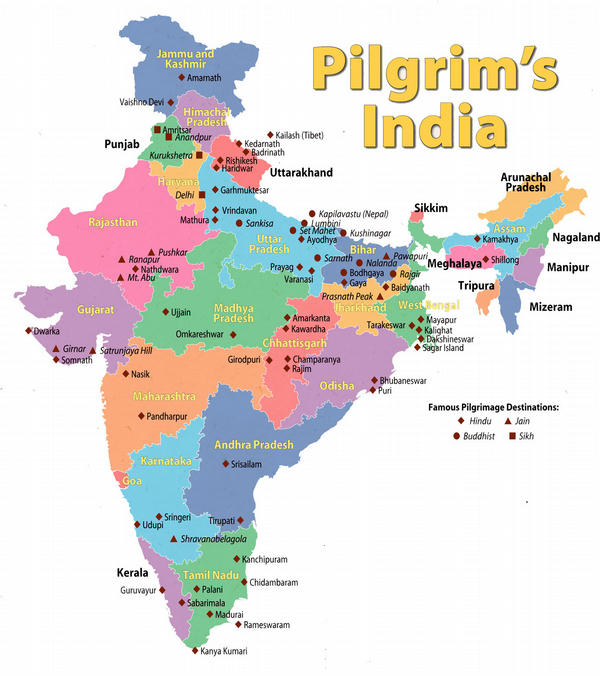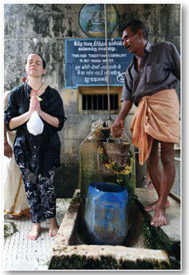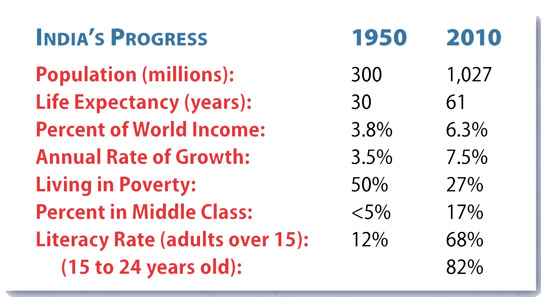Building a Unified Nation
What You Will Learn...§
1. India is a successful democracy.§
2. The Indian nation carefully managed its economy for steady growth.§
3. India is a secular country, but the various religions are not treated the same under the law.§
4. Pilgrimage is a popular religious practice that helps unify India.§
India’s unity and social and economic development have made it a major world power.
Key Terms§
![]() HINDUISM TODAY’S TEACHING STANDARDS§
HINDUISM TODAY’S TEACHING STANDARDS§
If this were YOU...
It is April 2010, and your parents have brought you to Haridwar from New York for the Kumbha Mela. You feel odd having to take a “bath” in the freezing Ganga surrounded by tens of thousands of strangers. But as you approach the river, those around you suddenly are like family. And after the bath, you are all talking together and laughing.§
What creates such feelings among strangers?§
BUILDING BACKGROUND: India’s constitution provides for “reservations” for members of the lower castes and tribes—historically disadvantaged people. A quarter to half of the seats in higher educational institutions and the jobs in government are set aside for these groups. Without such quotas, many would not qualify for the school or job.§
Planning for Progress
Newly independent India faced a host of problems—political, military, economic, social and religious. To maintain national unity, Nehru and the other great minds who oversaw the country’s early years focused on running a good government. They had two key strategies: 1) to keep India democratic by ensuring that every citizen had the opportunity to be part of the political process; 2) to modernize the nation through educational, economic and social development.§
The World’s Largest Democracy§
In all Indian general elections, the participation of the people has been enormous. Without a doubt, the democratic system has kept the country stable and united. But political parties quickly learned to win elections by creating “voting blocs,” groups of people who always vote for the same party. A party seeks to convince a group that only it can truly serve the group’s interests. Unfortunately, such appeals often run along narrow religious, ethnic, linguistic or caste lines. Issues that could otherwise be settled in a friendly manner are kept alive and used for political and occasionally treacherous ends.§
There remains one internal threat to the democratic order: communist-inspired local uprisings in India’s eastern states running from Bihar to Andhra Pradesh. Poor and tribal people support these armed separatist movements because they have seen little economic improvement in their region. Local police and government forces struggle to control these militant groups.§

Economic Development§
During India’s first decades, the economy was a mixture of state control and free enterprise. Prime Minister Nehru began a series of “five-year plans,” setting economic goals for agriculture, manufacturing, etc., to be met with government support. To prevent excessive profit-taking, the government set maximum prices for important goods. A few key industries were nationalized, such as banks. Heavy industries requiring large capital investment, such as steel and military arms manufacturing, were established and run by the government.§
Overseas investment was regulated. India’s years as a colony made her wary of letting foreign investors control any vital industry. Import duties were kept high, making it expensive to bring in foreign goods. India wanted to be self-sufficient and build its own economic infrastructure to meet the demands of its growing cities and villages.§
A major issue was food. India was not producing enough to feed her ever-increasing population and had to import nearly ten million tons of food yearly from the US. The technological advancements of the “Green Revolution” resulted in India’s complete self-sufficiency in food by 1969.§
India’s growth for the first 30 years was slow, but the economy was stable and urban unemployment low. By the 1980s and 90s, however, the world had changed. International trade and cooperation had increased. Countries with totally state-controlled economies—such as the Soviet Union and China—started having serious problems. In 1991, the Soviet Union broke up into many countries. Seeing a similar threat to its own economy, India began easing restrictions on industries and encouraging private business, free trade and foreign investment.§
The results were dramatic (see chart below). India’s rate of growth went from a low 3.5% to a healthy 7.5%. Its middle class rose from less than 5% of the population in 1950 to more than 17% today. The middle class is projected to reach 40% in 2025. India has evolved into a major world power through scientific and technological advancement, development of industries and defense build-up.§
Religious and Social Development§
India today is 81% Hindu, 13.4% Muslim, 2.3% Christian and 1.9% Sikh. It has the third largest population of Muslims in the world—161 million, after Indonesia and Pakistan. Relations between religions are generally peaceful, especially at a personal level. However, several religious riots and attacks have occurred at great loss of life.§
India’s constitution proclaims the country a secular state. Yet India does not treat all religions the same, as other secular governments do. For example, Indian state governments seized management of Hindu temples and control their income, yet they allow other religions the freedom to manage their own places of worship, including mosques and churches. The resulting oddity is that Hindu temple priests are virtually government employees. In addition, the laws regarding inheritance, marriage, divorce, adoption and other family issues are different for Hindus, Muslims and Christians. (For legal purposes, the term Hindu is defined to include Sikhs, Jains and Buddhists—all religions founded in India.) In truly secular nations, all religions follow the same laws and freely manage their own religious property. The unequal treatment of religions in India is an ongoing source of conflict. It is ironic that Hinduism, the majority religion, has fewer rights than minority faiths.§
One religious practice unites India as a nation: pilgrimage. There are hundreds of national pilgrimage destinations across India, and thousands at the regional level. The holy city of Varanasi welcomes 100,000 pilgrims a day, and a single temple, Tirupati, hosts 50,000 and more each day. Pilgrimage to religious sites is so popular that families plan their vacations around them. In India a vacation is not only for relaxation and fun; it is also a religious experience and opportunity for cultural interaction.§
Throughout Indian history, the movement of pilgrims has had significant impact on the religious and cultural unity of the country. Pilgrims create a continuous religious conversation as they travel about the land. Religious discussions form a bond among travelers and promote a sense of belonging to the country and religion. Such interactions are repeated at thousands of destinations each year.§
The map on page seven shows the most important Hindu pilgrimage sites in India, as well as those significant to Jains, Buddhists and Sikhs. Prominent sites, such as Varanasi, Mathura, Ayodhya, Ujjain and Rameswaram, attract huge crowds year around. Most sites, however, are crowded with devotees only during annual festivals. For example, hundreds of thousands attend the summer festival at the Jagannath Temple in Puri, Odisha. Three huge chariots carrying the temple Deities are pulled through the streets by crowds tugging on ropes a foot in diameter. Similarly, devotees of Lord Krishna flock to the towns of Vrindavan and Mathura during Krishna Janmashtami and other major festivals.§
Several pilgrimages require serious effort, such as Amarnath Cave. It is located 12,700 feet high in the Himalayas, in Jammu and Kashmir. Every summer 400,000 pilgrims walk on a narrow, rocky trail for four or five days to reach this sacred shrine to Lord Siva.§
RAMESWARAM§
The huge Rameswaram temple near the southern tip of India is a prime pilgrimage destination for Hindus of all sects. Here Lord Rama established a shrine to Siva upon Rama’s successful rescue of his wife Sita in Lanka, as recorded in the Ramayana.§
The central practice here is ritual bathing, a common practice at many pilgrimage destinations— Haridwar and Varanasi, for example. This doesn’t mean bathing with soap, but immersing oneself fully clothed in a river or lake as a blessing. Ritual bathing is found in Buddhism, Judaism, Christianity, Islam and other religions. The bathing may be full immersion, sprinkling or washing hands and feet.§
 At Rameswaram, there is not just one ritual bath, but 22, beginning in the nearby ocean. From that salty dip, you and your fellow pilgrims walk, completely soaked, to the temple. There a temple helper leads you to a courtyard inside the entrance where he drops a bucket 20 feet into the first well, pulls it back up by a rope and pours the holy water over your head. He then leads you rapidly, sometimes running, from well to well. You lose all sense of direction as you zig-zag through the stone corridors and courtyards of this ancient, labyrinthine temple. Despite the wells being so close together, their waters are of different tastes and temperatures. According to temple lore, the water of each cleanses the pilgrim of a specific sin. Devout pilgrims hold a past transgression firmly in mind while being doused by each bucketful of water, which they believe cleanses them of that particular karma. Skeptics are present, naturally, even among pilgrims. But few depart the 22nd well without a feeling that something quite extraordinary and purifying has happened to them during those two hours.§
At Rameswaram, there is not just one ritual bath, but 22, beginning in the nearby ocean. From that salty dip, you and your fellow pilgrims walk, completely soaked, to the temple. There a temple helper leads you to a courtyard inside the entrance where he drops a bucket 20 feet into the first well, pulls it back up by a rope and pours the holy water over your head. He then leads you rapidly, sometimes running, from well to well. You lose all sense of direction as you zig-zag through the stone corridors and courtyards of this ancient, labyrinthine temple. Despite the wells being so close together, their waters are of different tastes and temperatures. According to temple lore, the water of each cleanses the pilgrim of a specific sin. Devout pilgrims hold a past transgression firmly in mind while being doused by each bucketful of water, which they believe cleanses them of that particular karma. Skeptics are present, naturally, even among pilgrims. But few depart the 22nd well without a feeling that something quite extraordinary and purifying has happened to them during those two hours.§
REVIEWING IDEAS, TERMS AND PEOPLE§
- Explain: How did India’s economy change in the 1990s? Why?
- Evaluate: Is life for the average Indian better today than it was before independence? Provide several examples.
- Elaborate: Why do you think family laws are different for Hindus, Christians and Muslims in India?
- Describe: What do pilgrims do at Rameswaram temple? How does it affect their lives?

- Analyze: How does the practice of pilgrimage help unify India’s diverse peoples?
For some Indian states, such as Kerala and Uttar Pradesh, the economic activity generated by pilgrimage is a significant percent of the state’s total economy.§
ACADEMIC VOCABULARY§
treacherous§
having hidden and unpredictable dangers§
ethnic§
of a specific place, race, culture or religious origin§
nationalize§
government takeover of a business, such as a bank or railroad§
import duty§
a tax on goods brought into the country§
infrastructure§
the basic facilities of a nation such as roads, dams, bridges, phone systems, airports, railways§
urban§
cities and towns, in contrast to villages§
virtually§
almost or nearly the same as§
pilgrimage§
travel to a holy place for a religious purpose§
labyrinth§
a complex network of passageways§
lore§
knowledge and belief held by a group and passed on by word of mouth§




